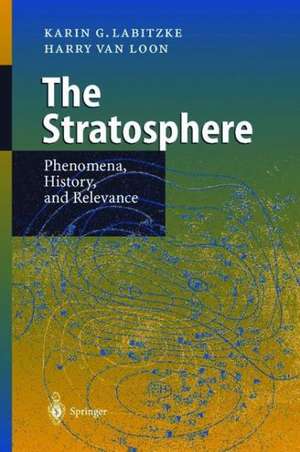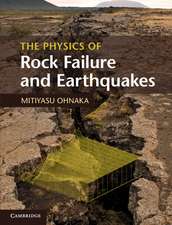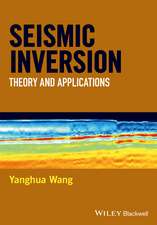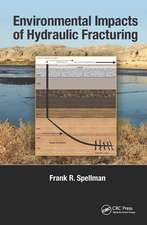The Stratosphere: Phenomena, History, and Relevance
Autor Karin G. Labitzke, Harry van Loonen Limba Engleză Paperback – 23 oct 2012
| Toate formatele și edițiile | Preț | Express |
|---|---|---|
| Paperback (1) | 382.36 lei 6-8 săpt. | |
| Springer Berlin, Heidelberg – 23 oct 2012 | 382.36 lei 6-8 săpt. | |
| Hardback (1) | 578.01 lei 6-8 săpt. | |
| Springer Verlag – iul 1999 | 578.01 lei 6-8 săpt. |
Preț: 382.36 lei
Nou
Puncte Express: 574
Preț estimativ în valută:
73.17€ • 79.46$ • 61.47£
73.17€ • 79.46$ • 61.47£
Carte tipărită la comandă
Livrare economică 23 aprilie-07 mai
Preluare comenzi: 021 569.72.76
Specificații
ISBN-13: 9783642636370
ISBN-10: 3642636373
Pagini: 196
Ilustrații: XII, 180 p. 78 illus., 20 illus. in color.
Dimensiuni: 155 x 235 x 10 mm
Greutate: 0.28 kg
Ediția:Softcover reprint of the original 1st ed. 1999
Editura: Springer Berlin, Heidelberg
Colecția Springer
Locul publicării:Berlin, Heidelberg, Germany
ISBN-10: 3642636373
Pagini: 196
Ilustrații: XII, 180 p. 78 illus., 20 illus. in color.
Dimensiuni: 155 x 235 x 10 mm
Greutate: 0.28 kg
Ediția:Softcover reprint of the original 1st ed. 1999
Editura: Springer Berlin, Heidelberg
Colecția Springer
Locul publicării:Berlin, Heidelberg, Germany
Public țintă
ResearchCuprins
1 Berlin and the Stratosphere.- 1.1 The first meteorological observations.- 1.2 The exploration of the free atmosphere.- 1.3 The discovery of the stratosphere.- 1.4 The Royal Prussian Aeronautical Observatory at Lindenberg.- 1.5 The Institute of Meteorology at the Freie Universität Berlin.- Literature.- 2 A Brief Description of the Stratospheric Climate.- 2.1 What kind of data is available today?.- 2.2 Mean conditions in the stratosphere.- 2.3 Variability and trends.- Literature.- 3 Warm and Cold Winters in the Stratosphere.- 3.1 Introduction.- 3.2 Synoptic description of a major midwinter warming.- 3.3 Associations.- 3.4 A comparison between the Arctic and Antarctic.- 3.5 Model experiments.- Literature.- 4 The Quasi-Biennial Oscillation (QBO).- 4.1 Early observations.- 4.2 The discovery of the QBO in the equatorial stratosphere..- 4.3 Our present concept of the QBO.- 4.4 The connection between the QBO and high northern latitudes.- Literature.- 5 The Ozone Layer.- 5.1 Introduction.- 5.2 Early observations.- 5.3 The natural distribution of total ozone.- 5.4 Loss of stratospheric ozone caused by man.- Literature.- 6 The 11-Year Sunspot Cycle and the Stratosphere.- 6.1 Introduction.- 6.2 The solar signal in the stratosphere during the year.- 6.3 Is there a connection to the tropical troposphere?.- 6.4 Total ozone and the 11-year sunspot cycle.- 6.5 In search of a physical-dynamical mechanism.- Literature.- 7 Final Remarks.- 7.1 A summary.- 7.2 Is the stratosphere relevant to our climate?.- 7.3 The unexpected.- Table of Boxes.
Caracteristici
including historical observations
Descriere
Descriere de la o altă ediție sau format:
This book presents the history, phenomena, and relevance of the stratosphere. Beginning with the discovery of the stratosphere itself, the book explores various unexpected phenomena observed in the stratosphere, such as the ozone hole in 1984 and the influence of the 11-year solar cycle in 1987. It describes the interrelations of stratospheric phenomena and its effects on the variability of the climate system, as well as examines various human impacts on the system such as the decrease in the ozone layer.
This book presents the history, phenomena, and relevance of the stratosphere. Beginning with the discovery of the stratosphere itself, the book explores various unexpected phenomena observed in the stratosphere, such as the ozone hole in 1984 and the influence of the 11-year solar cycle in 1987. It describes the interrelations of stratospheric phenomena and its effects on the variability of the climate system, as well as examines various human impacts on the system such as the decrease in the ozone layer.









